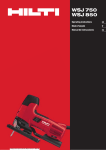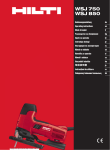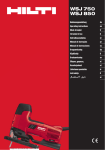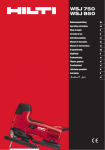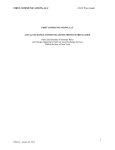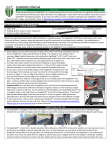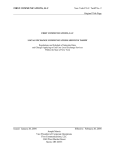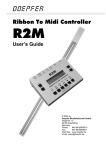Download HILTI WSJ 750 User's Manual
Transcript
377834 377834 WSJ 750/850 Bedienungsanleitung de Operating instructions en Mode d'emploi fr 1 WSJ 750-ET / WSJ 850-ET 2 1 3 4 5 6 7 14 13 12 WSJ 750-EB / WSJ 850-EB 8 11 9 10 1 16 3 4 15 5 6 7 14 13 12 8 11 9 10 16 15 2 1 4 3 2 3 4 4 2 2 1 1 5 3 5 6 1 1 4 2 3 3 2 7 4 8 1 1 2 2 10 9 III II I O 11 5 1 2 4 3/6 3/6 12 13 1 1 2/4 2 3 14 2 15 1 1 2 16 1 4 4 2 3 5 2 7 6 3 5 7 6 WSJ 750-ET / WSJ 750-EB / WSJ 850-ET / WSJ 850-EB orbital action jig saw and WSJ-DRS dust removal system It is essential that the operating instructions are read before the tool is operated for the first time. 1. General information 1.1 Signal words and their meaning Always keep these operating instructions together with the tool. -CAUTIONUsed to draw attention to a potentially dangerous situation which could lead to minor personal injury or damage to the equipment or other property. Ensure that the operating instructions are with the tool when it is given to other persons. -NOTEUsed to draw attention to an instruction or other useful information. 1.2 Pictograms Operating controls and parts On / off switch Lockbutton (only WSJ 750-ET and WSJ 850-ET) Ventilation slots Stroke rate adjustment thumbwheel Dust removal system connector Baseplate Orbital action adjustment lever Baseplate locking screw Guide roller Saw blade (insert tools) Guard Blade holder Saw blade release lever Dust removal hood Low-friction baseplate cover Anti-splinter insert Warning signs General warning Warning: electricity Warning: hot surface Obligation signs Wear eye protection Wear ear protection Wear protective gloves Wear breathing protection Symbols Read the operating instructions before use. Contents 1. General information 2. Description 3. Tools and accessories 4. Technical data 5. Safety precautions 6. Before use 7. Operation 8. Care and maintenance 9. Troubleshooting 10. Disposal 11. Warranty 12. EC declaration of conformity Page 13 14 14 15 16 18 19 20 21 22 22 23 These numbers refer to the corresponding illustrations. The illustrations can be found on the fold-out cover pages. Keep these pages open while studying the operating instructions. In these operating instructions, the WSJ 750-ET / WSJ 750-EB / WSJ 850-ET / WSJ 850-EB orbital action jig saw is referred to as “the tool”. Location of identification data on the tool The type designation and serial number can be found on the rating plate on the tool. Make a note of this data in your operating instructions and always refer to it when making an enquiry to your Hilti representative or service department. Type: Serial no.: 13 en 2. Description en 2.1 Correct use The tool is an electrically-powered orbital action jig saw for cutting wood, plastic, metal, plasterboard (drywall panel) and fiberboard. It is designed for professional use. The working environment may be a construction site, workshop, occupied living accommodation or other workspace and the work carried out may include construction, renovation or conversion. Use of the tool for cutting materials containing asbestos is not permissible. The tool may be powered only by an electric supply providing a voltage and frequency in compliance with the specification given on its rating plate. The items supplied include: – Electric tool incl. saw blade – Operating instructions, – Packaging – Accessories (dust removal module, anti-splinter insert, dust removal adaptor, low-friction baseplate cover, hex. socket wrench, dust removal hood) 3. Tools and accessories Saw blade Dust removal module Anti-splinter insert Dust removal adaptor Low-friction baseplate cover Hex. socket wrench Dust removal hood W-CS WSJ-DRS W-ASJ SS W-ASJ AS W-ASJ GL 5-W-A SW5 W-ASJ AH 3.1 WSJ-DRS dust removal module 3.1.4 Technical data WSJ-DRS dust removal module for the WSJ 850-ET and WSJ 850-EB Power input 80 W Suction performance 400 l/min Weight 250 g Dimensions (LxWxH) 150x60x100 mm 3.1.1 General information Location of identification data on the tool The type designation and serial number can be found on the rating plate on the tool. Make a note of this data in your operating instructions and always refer to it when making an enquiry to your Hilti representative or service department. Type: WSJ-DRS Serial no.: 3.1.2 Safety Use as directed The WSJ-DRS may be used only in conjunction with the WSJ 850-ET and WSJ 850-EB. Use of the WSJ DRS for materials containing asbestos or for metal, glass and carbon fiber dust is not permissible. Use of the WSJ-DRS for damp or explosive dust is not permissible. 3.1.3 General safety precautions When changing the filter, hold the tool and/or the WSJDRS so that the filter drawer can be pulled out vertically downwards. This prevents dust escaping. ● We recommend that breathing protection is worn when changing the filter. ● 14 3.1.5 Before use -NOTEThe dust removal hood must be fitted in front of the saw blade when the dust removal module is in use (see 6.5). Attaching the dust removal module 1. Unplug the supply cord from the electric socket. 2. Fit the dust removal adaptor into the opening on the tool. 3. Push the dust removal adaptor toward the tool from below until it engages. 4. Push the dust removal module onto the tool and the dust removal adaptor until it is heard to engage. Detaching the dust removal module 1. Unplug the supply cord from the electric socket. 2. Press the two buttons on the dust removal module (one on each side) and hold them in this position. 3. Pull the dust removal module away from the tool and the dust removal adaptor toward the rear. 4. Release the dust removal adaptor from the tool by pushing it downwards. 5. Push the dust removal adaptor downwards and pull it out of the tool. Emptying the dust container 3. Pull the dust container downwards away from the tool. 4. Empty the dust out of the container by tapping it lightly or, alternatively, use a vacuum cleaner to clean out the container (wear breathing protection). -CAUTION● ● ● Dust may be released into the air when emptying the dust removal module. Dust may be harmful to the respiratory system. Wear breathing protection. 3.1.6 Care and maintenance We recommend use of compressed air and a cloth for cleaning the dust removal module. Do not use water, oil, grease or cleaning agents. -NOTEHold the dust removal module so that the dust removal adaptor faces upwards. 1. Unplug the supply cord from the electric socket. 2. Press the two buttons on the dust removal module (one on each side) simultaneously. 3.1.7 Changing and cleaning the filter Change the filter if it becomes defective or if so badly soiled that cleaning is no longer possible. Disassemble it to facilitate thorough cleaning. Especially after cutting plaster or plasterboard (drywall panel), the filter should be cleaned thoroughly to ensure no loss of suction power by the dust removal system. Clean the filter carfully, using compressed air or a vacuum cleaner. 4. Technical data Tool Nominal power rating Mains frequency WSJ 750-ET WSJ 750-EB WSJ 850-ET WSJ 850-EB 750 W 750 W 850 W 850 W 50 / 60 Hz 50 / 60 Hz 50 / 60 Hz 50 / 60 Hz Nominal voltage 110 V 230 V 110 V 230 V Mains current 7.5 A 3.8 A 8.0 A 4,.1 A Weight of tool 2.6 kg 2.5 kg 2.6 kg 2.5 kg Dimensions (LxWxH) 256x75x201 mm 256x75x194 mm 256x75x201 mm 256x75x194 mm Stroke rate 900–3000 1/min. 900–3000 1/min. 900–3000 1/min. 900–3000 1/min. Stroke 28 mm 28 mm 28 mm 28 mm Max. cutting depth in wood up to 120 mm up to 120 mm up to 150 mm up to 150 mm Max. cutting depth in aluminium up to 25 mm up to 25 mm up to 25 mm up to 25 mm Max. cutting depth in mild steel up to 10 mm up to 10 mm up to 10 mm up to 10 mm Angular cutting (left / right) 0–45° 0–45° 0–45° 0–45° Number of orbital action settings 0-1-2-3 0-1-2-3 0-1-2-3 0-1-2-3 Blade connection end T-shank T-shank T-shank T-shank Dust removal adapter exterior dia. 30 mm for hose adapter Double insulated (in accordance with EN 50144) protection class II (double insulated) Z Vibration-absorbing grip Interference immunity Radio and television interference suppression In accordance with EN 55014-2 In accordance with EN 55014-1 Noise and vibration information (measured in accordance with EN 50144) Typical A-weighted sound power level (LwA): ≤ 101 dB (A) WSJ-EB / ≤ 100 dB (A) WSJ-ET Typical A-weighted sound pressure level (LpA): ≤ 88 dB (A) WSJ-EB / ≤ 87 dB (A) WSJ-ET Wear ear protection! Typical weighted vibration at the grips: 3.1 m/s2 WSJ-EB / 3.0 m/s2 WSJ-ET Right of technical changes reserved! 15 en 5. Safety precautions en 5.1 Basic information concerning safety In addition to the information relevant to safety given in each of the sections of these operating instructions, the following points must be strictly observed at all times. -ATTENTIONRead all safety precautions and instructions! Failure to observe the following safety precautions and instructions may lead to electric shock, fire and/or serious injury. Observe the information given in the operating instructions concerning operation, care and maintenance. ● Nevertheless, the tool and its accessories may present hazards when used incorrectly by untrained personnel or when misused. ● Do not make use of incorrect accessories (e.g. the wrong circular saw blade, the wrong extraction connector or the wrong type of vacuum cleaner). ● To avoid the risk of injury, always use only Hilti original accessories. ● Connect the tool to an external dust removal system if the material to be cut produces dust hazardous to health. ● Modification of the tool is not permissible. ● Do not use the tool for cutting tree branches or logs. ● 5.2 Take the necessary precautions to make the workplace safe Ensure that the workplace is well lit. Ensure that the workplace is well ventilated. Keep the working area tidy. Objects which could cause injury should be removed from the working area. Untidiness at the workplace may lead to accidents. ● Keep the area above and below the cutting line free of obstacles. ● Secure the workpiece. Use clamps or a vice to hold the workpiece securely in position. It is then held more safely and both hands remain free for holding and operating the tool. ● Wear protective goggles. Wear breathing protection if the work creates dust. ● Wear suitable working clothing. Do not wear loose clothing, loose long hair or jewelry as these can become caught up in moving parts. Wear a hair net if you have long hair. ● When working, keep other persons, particularly children, outside the range of the tool. Do not permit other persons to touch the electric tool or the extension cord. ● Avoid unusual body positions. Work from a secure stance and stay in balance at all times. ● ● ● 16 Connect the dust removal system. Ensure that it is connected and used correctly. ● To avoid tripping and falling when working, always lead the supply cord, extension cord and extraction hose away to the rear. ● Concealed electric cables or gas and water pipes present a serious hazard if damaged while you are working. Accordingly, check the area in which you are working beforehand (e.g. using a metal detector). Avoid contact between your body and earthed / grounded objects, such as pipes or radiators. External metal parts of the tool may become live, for example, when an electric cable is damaged inadvertently. ● 5.3 General safety precautions Use the right electric tool for the job. Do not use the tool for purposes for which it was not intended. Use the tool only as directed and when it is in faultless condition. ● Use only the original accessories and auxiliary equipment listed in the operating instructions. Use of accessories or items of auxiliary equipment other than those listed in the operating instructions may present a risk of personal injury. ● Take the influences of your surroundings into account. Do not expose the tool to rain or snow and do not use it in damp or wet conditions. Do not use the tool where there is a risk of fire or explosion. ● Keep the tool, especially its grip surfaces, clean and free from oil and grease. ● Do not overload the tool. It will operate more efficiently and more safely within the performance range for which it was designed. ● Always hold the tool securely, with both hands on the grips provided. ● Switch on the tool only after it has been brought into position where the cut is to be made. ● The dust removal hood should not be disassembled. ● Store tools in a safe place when not in use. When not in use, tools should be stored in a dry, high place or locked away where they are out of reach of children. ● Avoid unintentional starting. Do not carry the tool with your finger on the on/off switch. Check that the on / off switch is in the “off” position before plugging the supply cord into the electric socket. ● Disconnect the supply cord plug from the socket when the tool is not in use (e.g. during breaks, before maintenance and before changing insert tools). ● Switch the tool off before transporting it. ● Take care of your insert tools. You will be able to work more efficiently and more safely if the insert tools are kept sharp and clean. Observe instructions on care and maintenance and on changing insert tools. ● Check that all moving parts are undamaged and that they function properly without sticking. All parts must be fitted correctly and fulfill all of the conditions necessary to ensure faultless operation. ● Never place your hands in front of or on the saw blade. ● Check the tool for possible damage. Protective devices and any parts that may have suffered slight damage should be checked for correct operation and functionality before further use of the electric tool. Safety devices or other parts that are found to be damaged must be replaced or repaired properly by an authorized repair workshop unless otherwise indicated in the operating instructions. ● 5.3.1 Mechanical Check that wrenches etc. have been removed from the tool before switching it on. ● Observe the instructions concerning care and maintenance and replacement of insert tools in good time. ● Ensure that the insert tools used are equipped with the correct connection end system and that they are properly fitted and secured in the chuck. ● The safety guard for the saw blade must always be fitted in order to prevent inadvertent contact with the saw blade or the moving parts above the saw blade. ● 5.3.2 Electrical Protect yourself against electric shock. Avoid body contact with earthed / grounded objects, e.g. pipes and radiators etc. ● Check the condition of the tool’s supply cord at regular intervals. The supply cord should be replaced by a trained electrical specialist if damage is found. Also regularly check the condition of extension cords and replace these if damage is found. ● Check the condition of the tool. Do not operate the tool if it is found to be damaged, if it is not complete or if its controls cannot be operated faultlessly. ● Do not touch the supply cord in the event of it suffering damage while working. Disconnect the supply cord plug from the socket. ● Damaged switches must be replaced at a Hilti service center. Do not use the tool if it cannot be switched off and on properly. ● The tool should be repaired only by a trained electrical specialist (Hilti service center using original Hilti spare parts. Failure to observe this point may result in a risk of accident to the user. ● Do not use the supply cord for purposes for which it is not intended. Never carry the tool by the supply cord. Do not pull the plug out of the socket by pulling the supply cord. ● Do not expose the supply cord to heat, oil or sharp edges. ● When working outdoors, use only extension cords approved and correspondingly marked as suitable for outdoor use. ● In the event of a power cut: Switch off and unplug the tool. ● Avoid using extension cords with multiple sockets and the simultaneous use of several electric tools connected to one extension cord. ● Never operate the tool when it is dirty or wet. Dust or dampness on the surface of the tool make it difficult to hold and, under unfavorable conditions, may lead to electric shocks. Accordingly, have the tool checked regularly at a Hilti service center if it is used frequently for cutting conductive materials. ● 5.3.3 Thermal Warning: hot surface ● Wear protective gloves The insert tool may become hot during use. You should therefore wear protective gloves when changing insert tools. 5.3.4 Dust Wear respiratory protection when the work causes dust. ● Before beginning work, find out the hazard class of the dust produced by the work. Use only an industrial vacuum cleaner with an officially approved protection classification in compliance with your local dust control regulations for work with the tool. ● 5.4 Requirements to be met by users The tool may be operated, serviced and repaired only by authorized, trained personnel. This personnel must be informed of any special hazards that may be encountered. ● Always concentrate on the job you are doing. Proceed carefully and do not use the tool if your full attention is not on the job. ● 5.5 Personal protective equipment The user and any other persons in the vicinity must wear suitable eye protection, ear protection and protective gloves. They must also wear respiratory protection if no dust removal system is used. Wear eye protection Wear ear protection Wear protective gloves Wear breathing protection 5.6 Protective devices Never operate the tool without the applicable protective devices (dust hood). 17 en 6. Before use -CAUTION- en ● ● ● The cutting edges of the saw blade are sharp. The cutting edges may present a risk of injury. Wear protective gloves. 6.1 Extension cords If extension cords are used: Use only extension cords of a type approved for the intended purpose and of adequate cross section. Failure to observe this point may result in reduced performance and may cause the cord to overheat. Replace damaged extension cords. Use only correspondingly marked and approved extension cords for working outdoors. Recommended minimum cross sections and max. cord lengths: Mains voltage Conductor cross section 110 V 230 V 1.5 mm2 2.5 mm2 20 m 50 m 30 m 100 m Extension cords for outdoor use For outdoor work use only extension cords approved and correspondingly marked as suitable for outdoor use. 6.2 Fitting the saw blade 1. Unplug the supply cord from the electric socket. 2. Press the saw blade release lever and hold it in this position. 3. Push the saw blade into the blade holder (teeth facing cutting direction) until it engages. 4. Hold the blade against the resistance felt and then allow the blade release lever to return to its original position. 5. Check that the blade is held securely by gripping and pulling it. 6.3 Changing the saw blade -NOTEWhen changing the saw blade, hold the tool in such a way that persons or animals cannot be injured by the saw blade as it is ejected. 1. Unplug the supply cord from the electric socket. 2. Press the saw blade release lever to the side as far as it will go. The saw blade is then released and ejected. 6.4 Dust removal using an external dust removal system -NOTEUse of a dust removal system reduces exposure to dust, increases safety at the workplace by ensuring better vis18 ibility of the cutting line and helps to keep the workplace tidy by greatly reducing the amount of dust and wood chips in the working area. Connect the external dust removal system before working with the tool for long periods when cutting wood or other materials that may cause considerable dust. The dust removal hood must be fitted when the tool is being used with a dust removal system. 6.4.1 Connecting the system 1. Unplug the supply cord from the electric socket. 2. Fit the dust removal adaptor into the opening on the tool. 3. Push the dust removal adaptor toward the tool from below until it engages. 4. Connect the vacuum cleaner hose to the dust removal adaptor. 6.4.2 Disconnecting the system 1. Unplug the supply cord from the electric socket. 2. Disconnect the vacuum cleaner hose from the dust removal adaptor. 3. Push the dust removal adaptor downwards and pull it out of the tool. 6.5 Dust removal hood 6.5.1 Fitting the dust removal hood 1. Unplug the supply cord from the electric socket. 2. Push the dust removal hood onto the tool from the front until it engages. 6.5.2 Removing the dust removal hood 1. Unplug the supply cord from the electric socket. 2. Tilt the dust removal hood slightly and pull it away from the tool toward the front. 6.6 Sawdust blower The blower keeps the cutting line free of dust and chips by directing a jet of air toward the saw blade. 6.7 Adjusting the orbital action The four orbital action settings permit cutting performance and quality of cut to be adjusted to suit the material being cut. Orbital action adjustment lever is used to set the tool to one of the four orbital action settings. Please observe the following recommendations: The lower the orbital action setting, the finer and cleaner the cut. The optimum setting can be determined by making test cuts. Setting 0: Setting I: Setting II: SettingIII: No orbital action Low orbital action Medium orbital action High orbital action Please refer to the information provided with the saw blade for details of correct settings. 6.8 Adjusting the stroke rate 1. Set the stroke rate adjustment thumbwheel to a position between 1 (slow) and 6 (fast). Please refer to the information provided with the saw blade for details of correct settings. 6.9 Adjusting the cutting angle 6.9.1 Setting the cutting angle 1. Unplug the supply cord from the electric socket. 2. Remove the dust removal system adaptor. 3. Release the screw. 4. Pull the baseplate slightly toward the front of the tool. 5. Set the baseplate to the desired angle according to the scale on the tool. 6. Tighten the screw. 6.9.2 Resetting the cutting angle 1. Unplug the supply cord from the electric socket. 2. Release the screw. 3. Return the baseplate to the 0° position. 4. Push the baseplate back to its original position (toward the rear of the tool). 5. Tighten the screw. 6.10 Offsetting the baseplate To facilitate sawing close to edges, the baseplate can be repositioned as follows: 1. Unplug the supply cord from the electric socket. 2. Release the screw. 3. Push the baseplate back as far as it will go. 4. Tighten the screw. 6.11 Anti-splinter insert -NOTEThe anti-splinter insert cannot be used with certain types of saw blades (e.g. offset blades). Use of the anti-splinter insert helps prevent splintering of the surface when sawing wood materials. 1. Unplug the supply cord from the electric socket. 2. Press the anti-splinter insert into the baseplate from below. 6.12 Low-friction baseplate cover -NOTEUse the low-friction baseplate cover to avoid scratching sensitive materials. 1. Unplug the supply cord from the electric socket. 2. Hook the cover onto the front edge of the baseplate. 3. Press the cover against the baseplate until it snaps into place. 7. Operation -CAUTION● ● -CAUTION● ● ● The cutting edges of the saw blade are sharp. The cutting edges may present a risk of injury. Wear protective gloves. -CAUTION● ● ● The sawing operation swirls up dust and wood chips into the air. The dust and wood chips may be harmful to the eyes and respiratory system. Wear protective goggles and breathing protection. ● Operation of the tool creates noise. Excessive noise may damage the hearing. Wear ear protection. 7.1 System -NOTE● To achieve good cutting performance and ease the load on the tool, always use blades that are in good condition. ● Do not overload the tool. -CAUTIONWhen working with the tool, always guide it away from the body. ● Lift the tool away from the workpiece only after the blade has come to a standstill. ● 19 en ● Lay the tool down only after the blade has come to a standstill. -CAUTION● en ● ● The saw blade becomes hot during long periods of use. There is a risk of burning if the blade is touched. Wear protective gloves. 7.2 Switching on / off 7.2.1 On / off switch (WSJ 750-ET / WSJ 850-ET) 1. Plug the supply cord into the electric socket. 2. Switch the tool on by pressing the on / off switch. – Switching on: Press the on / off switch. – Switching off: Release the on / off switch. – Sustained operation: Press the on / off switch and then press the switch lockbutton. – Switching off: Press the on / off switch again and then release it. 7.2.2 On / off switch (WSJ 750-EB / WSJ 850-EB) 1. Plug the supply cord into the electric socket. 2. Switch the tool on / off by way of the sliding switch. 7.3 Plunge sawing -NOTEUse the plunge sawing method only for soft materials. Only short blades should be used. 1. Plug the supply cord into the electric socket. 2. Set the orbital action regulation lever to the 0 position. 3. Bring the front edge of the baseplate into contact with the workpiece. 4. Hold the tool securely and press the on / off switch. 5. Press the tool firmly against the workpiece and begin the plunge movement by reducing the angle between the baseplate and the workpiece. 6. Once the blade has penetrated the workpiece, bring the tool into the normal working position (with the entire baseplate surface in contact with the workpiece). 7. Continue sawing along the cutting line. 8. Care and maintenance Unplug the supply cord from the electric socket. 8.1 Care of blades Used saw blades should be cleaned to remove resin deposits at regular intervals as clean blades achieve a higher cutting performance. Resin deposits can be removed by placing the saw blades in a bath of paraffin (kerosene) or commercially available resin remover for 24 hours. ● 8.2 Care of the tool The tool was lubricated adequately when it was manufactured. After long periods of heavy use it is recommended that the tool is inspected and serviced at a Hilti workshop. This will increase the life expectancy of the tool and avoid unnecessary repair costs. ● Repairs to the electrical section of the tool may be carried out only by a trained electrical specialist. The outer casing of the tool is made from impact-resistant plastic. Sections of the grip are made from an elastomer material (WSJ 850-ET/-EB). Never operate the tool when the ventilation slots are blocked. Clean the ventilation slots carefully using a dry brush. Do not permit foreign objects to enter the interior of the tool. Clean the outside of the tool at regular intervals using a slightly damp cloth. Do not use a spray, steam pressure cleaning equipment or running water for cleaning. This may negatively affect the electrical safety of the tool. Always keep the grip surfaces of the tool free from oil and grease. Do not use cleaning agents which contain silicone. 8.3 Maintenance Check all external parts of the tool for damage at regular intervals and check that all controls operate faultlessly. Do not operate the tool if parts are damaged or when the controls do not function faultlessly. If necessary, your electric tool should be repaired at a Hilti repair center. Repairs to the electrical section of the tool may be carried out only by trained electrical specialists. ● 20 8.4 Checks after care and maintenance After care and maintenance, check that all protective devices are fitted and that they function faultlessly. 9. Troubleshooting Fault The saw blade drops out. Possible cause Remedy The saw blade is not engaged correctly. Reinsert the saw blade, taking care to ensure that the blade holder is fully open and the saw blade is pushed in against the resistance felt. The blade clamping mechanism is Clean the blade holder. dirty. The saw blade cannot be The blade clamping mechanism is Clean the blade holder. inserted. dirty. The tool cannot be The supply cord is not plugged in. Check that the supply cord is plugged in. switched on. The switch is defective or dirty. Clean the exterior of the switch with a cloth or have the switch checked by a trained electrical specialist. The switch cannot be lock- The switch is defective or dirty. Clean the exterior of the switch with a ed in the sustained running cloth or have the switch checked by a position (WSJ 750-ET and trained electrical specialist. 850-ET) The orbital action cannot The tool is dirty. Clean and remove foreign matter from be adjusted. the slot for the orbital action adjustment lever. No orbital action. The tool is dirty. Check the area of the orbital action fork and remove any dirt or foreign matter. The orbital action adjustment lever Set the lever to the desired position. is set to the "0" position. Speed cannot be adjusted. The stroke rate adjustment thumb- Clean the exterior of the thumbwheel or wheel is dirty or defective. have the tool checked by a trained electrical specialist. Speed too high or too low. The wrong stroke rate is set. Check the stroke rate setting (scale on the thumbwheel) and adjust it accordingly. Dust removal with the The dust removal hood is not fitted. Check that the vacuum cleaner is working vacuum cleaner or dust and that the dust removal adaptor and removal module doesn’t dust removal hood are fitted. work. The passages in the tool and / or dust Clean the passages in the tool or dust removal adapter are dirty or blocked. removal adapter. The baseplate cannot be The securing screw has not been Check the screw and release it if necespivoted. released or the connection between sary. Clean the area between the baseplate the baseplate and the tool is dirty. and the tool. An accessory cannot The point of attachment to the base- Clean the point of attachment to the basebe fitted (WSJ 850-ET/-EB) plate is dirty or the wrong accessory plate and check whether a suitable accesis being used. sory is being used. The dust removal module The module is not correctly attached Check that the module is correctly doesn’t function. to the tool. attached to the tool. The dust container is full. Empty the dust container. The filter is dirty. Clean the filter or fit a new dust container. The cut is not straight. The blade is unsuitable for the Use the saw blade recommended by Hilti application. for the application you are carrying out. The blade is blunt or damaged. Use a suitable, new saw blade. The material being cut Stroke rate and cutting force is too Reduce the stroke rate and apply less overheats. high. pressure. The material being cut Inadequate lubrication when cutting Use a new saw blade and ensure adequate overheats (metal). metal. lubricant is applied between the saw blade and workpiece. 21 en 10. Disposal Most of the materials from which Hilti electric tools are manufactured can be recycled. The materials must be correctly separated before they can be recycled. In many countries, Hilti has already made arrangements for taking back your old electric tools for recycling. Please ask your Hilti customer service department or Hilti representative for further information. Should you wish to return the electric tool yourself to a disposal facility for recycling, proceed as follows: Dismantle the electric tool as far as possible without the need for special tools. Use absorbent paper to wipe oily parts clean and to collect any grease that runs out (total quantity approx. 50 ml). This paper should also be disposed of correctly. On no account should oil or grease be allowed to enter the waste water system or to find its way into the ground. The individual parts should be separated as follows: Part / assembly Main material Toolbox Plastic Gear housing Plastic with magnesium alloy / brass parts Grip Plastic Motor housing Plastic Fan Plastic Motor (rotor and stator) Steel and copper Supply cord Copper, elastomer Gearing parts Metal Main switch, electronics Baseplate (WSJ 750-EB/- ET) Steel Baseplate (WSJ 850-EB/-ET) Cast aluminium and steel Baseplate cover Plastic Anti-splinter insert Plastic Dust removal adaptor Plastic Screws, small parts Steel Operating instructions Paper Recycling Plastics recycling Scrap metal Plastics recycling Plastics recycling Plastics recycling Electronic scrap Electronic scrap Scrap metal Electronic scrap Scrap metal Scrap metal Plastics recycling Plastics recycling Plastics recycling Scrap metal Paper recycling 11. Warranty Hilti warrants that the tool supplied is free of defects in material and workmanship. This warranty is valid as long as the tool is operated and handled correctly, cleaned and serviced properly and in accordance with the Hilti operating instructions, all warranty claims are made within 12 months (unless other mandatory national regulations prescribe a longer minimum period) from the date of the sale (invoice date), and the technical system is maintained. This means that only original Hilti consumables, components and spare parts may be used in the tool. This warranty provides the free-of-charge repair or replacement of defective parts only. Parts requiring repair or replacement as a result of normal wear and tear are not covered by this warranty. Additional claims are excluded, unless mandatory national rules prohibit such exclusion. In particular, Hilti is not obligated for direct, indirect, incidental or consequential damages, losses or expenses in con22 nection with, or by reason of, the use of, or inability to use the tool for any purpose. Implied warranties of merchantability or fitness for a particular purpose are specifically excluded. Send the tool and/or related parts immediately upon discovery of a defect to the local Hilti marketing organisation for repair or replacement. This constitutes Hilti’s entire obligation with regard to warranty and supersedes all prior or contemporaneous comments and oral or written agreements concerning warranties. 12. EC declaration of conformity Designation: Type: Year of design: Orbital action jig saw WSJ 750-ET / WSJ 750-EB / WSJ 850-ET / WSJ 850-EB and WSJ-DRS 2003 en We declare, on our sole responsibility, that this product complies with the following directives and standards: 73/23/EWG, 89/336/EWG, 98/37/EG, EN 55014-1, EN 55014-2, EN 50144-1, EN 50144-2-10, EN 610003-2, EN 61000-3-3. Hilti Corporation Ronald Fehlmann Head of BU Cutting and Sanding March 2003 Dr. Heinz-Joachim Schneider Head of BA Light Duty Systems March 2003 23 Hilti Corporation Hilti = registered trademark of Hilti Corp., Schaan W 2750 1003 25-Pos. 1 1 Printed in Liechtenstein © 2003 Right of technical and programme changes reserved S. E. & O. 377834 / A FL-9494 Schaan Tel.: +423 / 234 2111 Fax: +423 / 234 29 65 www.hilti.com

















